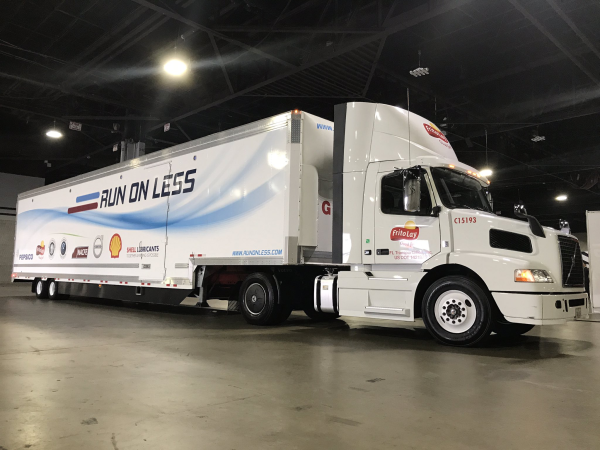Run on Less trucks hit average of 10.1 mpg during 17-day demonstration
ATLANTA, Ga. – Drivers in the Run on Less demonstration exceeded all expectations and hit an average of 10.1 mpg during the 17-day project.
The North American Council for Freight Efficiency (NACFE) made the announcement on September 24 at the inaugural North American Commercial Vehicle Show in Atlanta, where they proclaimed that “10 mpg is possible with today’s technologies.” 
Run on Less is the first of its kind cross-country road show, where seven drivers drove their regular route for seventeen days, and their fuel mileage was monitored and posted live during the duration of the project. NACFE expected drivers to hit an average of 9 mpg, and in reality, the drivers together hit an average of 10.1 mpg.
“We hosted the Run to demonstrated that with the right investment in technology, and with skilled, ambitious drivers, it is possible to achieve mpg levels far above the average fleet,” Mike Roeth, executive director of NACFE said.
In total all seven drivers, that were hand-selected, drove a total of 50,107 total miles. They saved 2,877 gallons of diesel fuel and $7,193 against the national average of 6.4 mpg. Of the combined days on the road, the highest recorded mpg was 12.8, and three drivers reached more than 12.5 mpg. The average for all of the lowest mpg days during the run was 8.8 – not a far cry from the actual project’s goal of 9 mpg.
“Nine mpg was the goal, so to hear that we not only met but exceed the goal is outstanding,” said Annie Peter from Shell, a sponsor of the demonstration. “It will take collaboration among energy suppliers, lubricant producers and fuel retailers like Shell, vehicle manufacturers, fleet owners, businesses and other organizations to work together to consistently achieve the impressive fuel economy and CO2 reductions these seven drivers accomplished during the Run.”
According to NACFE, these results are staggering when you connect the dots and realize that if the 1.7 million trucks on the North American highways today achieved the same level of efficiency as the truck in Run on Less, they would save 9.7 million gallons of fuel, $23.4 billion, and 98 million tons of carbon dioxide each year.
The trucks participating included three Freightliners, two Internationals, and two Volvos. The drivers were: Henry Albert, Bradley Long, Tommy Revell, Roberto Sandoval, Joel morrow, Clark Reed, and Mark Risien. They faced challenges like Hurricane Irma and Harvey, congestion, and heavy loads. Trucks were equipped with things like automated transmissions, 6×2 axles, tractor and trailer aerodynamics, engine accessories, and tire pressure mentoring systems. The drivers were also experienced and kept an average speed of 54 mph.
One day, a driver even traveled a 3,270-ft. elevation gain with a 72,960-lb gross combination weight and experienced an average of 2.7 mph headwind and still achieved 9.7 mpg.
“We know that equipping these trucks with the technology costs money…but one thing we’ve learned is in the 4-5 years NACFE’s been doing this is there’s a cost of the technology, usually an increase there’s fuel savings, but we’ve found very few times where the total cost of ownership stops there,” Roeth said at the announcement. “So there’s usually other benefits that will help save money. That total picture is what we try to focus on in out work. And that’s what we told the drivers, bring the technology that you have and would want to buy, don’t get them just to get that extra mpg. Bring what you have as a current spec’. We believe these technologies pay back because they’ve procured them.”
You can learn more about the achievements of the Run on Less demonstration at www.runonless.com.
Have your say
This is a moderated forum. Comments will no longer be published unless they are accompanied by a first and last name and a verifiable email address. (Today's Trucking will not publish or share the email address.) Profane language and content deemed to be libelous, racist, or threatening in nature will not be published under any circumstances.
-
“Average speed”. Not top speed.
Wow! Does anyone proofread anymore???
It’s like English is a second language to you. Oh wait, you’re a Canadian publication so maybe it is 😉
And how many drivers do you know that will average 54 mph – I am sure that the freight will not make any “on time delivery” at that rate – let alone getting tied up in traffic. That speed is unrealistic and unproductive.